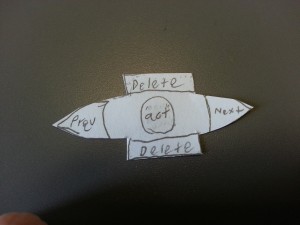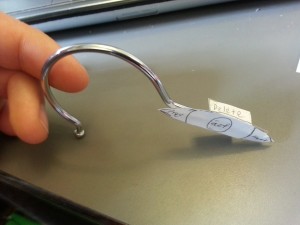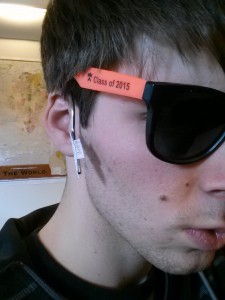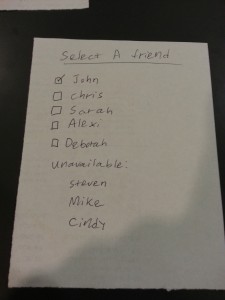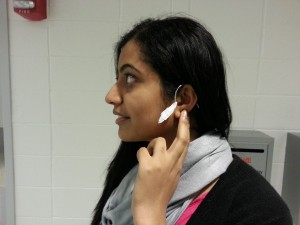I. Observation-I conducted my observations on three separate occasions before three different classes that I arrived early to.
A. Before HCI Lecture on Thursday 2/21, I observed two students speaking with each other as they unpacked their book bags and prepared for lecture. Their discussion focused on which classes they were both taking, since one had recently decided between two classes that he had been shopping. After they finished setting out their items for lecture (one had taken his computer out of his backpack, while the other had removed a pencil and paper), they sat down and continued discussing the weekend’s activities. Many people seem to use the time between classes socially like this pair. It’s possible that some method for facilitating communication would be helpful.
B. There’s a girl in my African Dance class who arrives at least 10 minutes early to every class and spends the time reading her organic chemistry textbook. I don’t actually know exactly when she arrives, but she is always sitting outside the room on a bench reading when I arrive at class. I observed her on Wednesday, 2/20, and saw that she was working on a problem from one of the chapters in her textbook. Since she is always studying the same subject, I would guess that her class schedule for orgo syncs up with our dance class such that she always has the same amount of time before her next orgo class when I see her. It’s not uncommon for students to spend their spare time between classes studying. There are, however, few assignments that lend themselves to the sort of burst studying-10minutes of work, 50 minutes of other activities-that the current class model encourages.
C. When I arrived in my COS 226 precept on Thursday, 2/21, the guy sitting in front of me had his laptop out and was clicking through emails, deleting and replying as necessary. Given the volume of email that arrives at the average Princeton.edu address each day, I would expect that checking email would be a major activity for the 10 minutes between classes. All of the subjects I observed had found useful things to do with the time between classes. This indicates to me that one way to improve the time might be to make more of it available to them, by shortening the time they spend traveling between classes.
II. Ideas:
- A phone application that tracks your fastest routes between classes
- A bike-sharing program tailored to high traffic times and areas
- An earpiece that lets you page through emails as you walk
- Recordings of textbooks that you could study as you walk
- Quiz questions that could be answered from the lecture hall or en route to class
- Concurrent lectures given in the same space using headphones for students
- An app that tracks your friends’ daily walking routes and plans intersections into your route
- An app that lets you know which of your friends are in which dining/lecture halls
- A music player that selects a song based on the walking speed necessary for you to be on time
- A personal rapid transit network of autonomous golf carts
- A program that automatically downloads your lecture slides from blackboard
- A motorized system for carrying bikers and skateboarders to elevated parts of campus
- An app that tracks your sleep and recommends caffeine before classes as necessary
- An app that alerts you to leave based on average times to reach your classes
- A device that lets you review your notes as you walk
III. I chose to prototype my earpiece that pages through emails (#3), not because I felt it was my best idea, but because i had questions about the physicality of the device and how it would affect its usefulness. I chose to prototype my app for tracking friends’ walking routes (#7), because it seemed like the interface design would be important to the success of the app.
IV. Prototypes:
My prototype for idea 3 involved a broken coat hanger I had lying around and some paper buttons. I tried to keep the interface as simple as possible, with only four buttons (aside from an assumed power switch). I wanted to test whether a simple, intuitive, physical interface could still be valuable in an application that could be implemented as a phone app.
For Idea number 7, I prototyped by drawing up a very basic phone interface. I went for a simple app that was designed to be used for 10 minutes at a time.
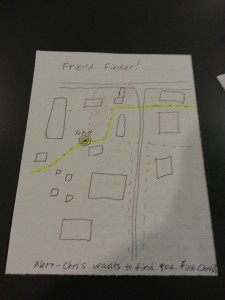
Map page. The map displays the selected friend’s location, as well as their predicted route based on their travel history at the current time of day.
V. Testing
I tested my prototype for idea #3 on several students at different times:
A. Student 1 said she thought the earpiece would be useful, and complained about how much time she spent checking email each day. She reported checking email quickly in between classes, as well as on her laptop in extended sessions. She complained that the prototype fit loosely on her ear. She felt that having a physical device was useful in that it would allow her to check her email intuitively on the move.
B. Student 2 said he didn’t see the point of the physical device, and felt he would prefer that the same functionality be implemented on his cellphone with a pair of headphones. He agreed that having emails read to him via text to speech synthesis would be useful in checking email between classes, but didn’t see the use of a dedicated physical device. Student 2 said he felt “overwhelmed” by the daily volume of email he received, and did say that he would appreciate creative solutions to help him stay on top.
C. Student 3 said she thought the buttons were nice, but would probably not spend too much money to have a separate physical device when she could get the same functionality out of her phone. When asked if she would consider using the device to write emails (via speech to text synthesis), she said that she probably would not because she would feel as if her privacy were not being protected if she had to speak her emails aloud in public.
D. Student 4 also felt overwhelmed by the amount of email she received each day. She reported checking email on her laptop between classes, in addition to spending roughly an hour each night checking her email at home. Student 4 was unique among the users tested in that she alone did not own a smart phone, and only used her laptop to check her email. Tellingly, even she felt that the device would probably not be worth its cost when she could check her email on her laptop in class.
VI. Insights Gained from Testing
From my testing, I concluded that the physical headset is probably not worth the production cost in my model. most users would prefer to use their phone and a pair of headphones.
The idea of synthesizing text to speech for email checking is sound, and could be valuable to users who like to check their email in short bursts. Many users praised the simplicity of the interface, and said they would benefit from an application that would make it easier to check email while in transit. Thus, while the functionality of the tested design is sound, testing indicates it would be better implemented as a software application for a mobile phone.

